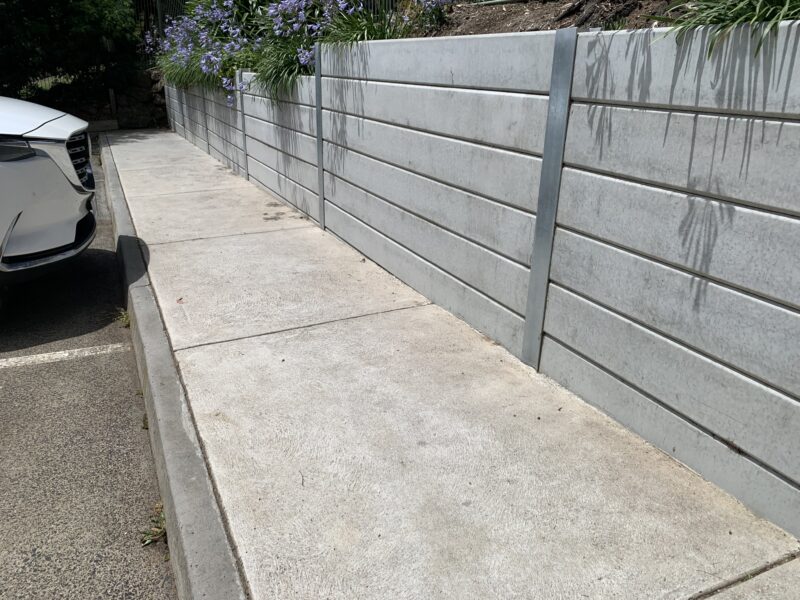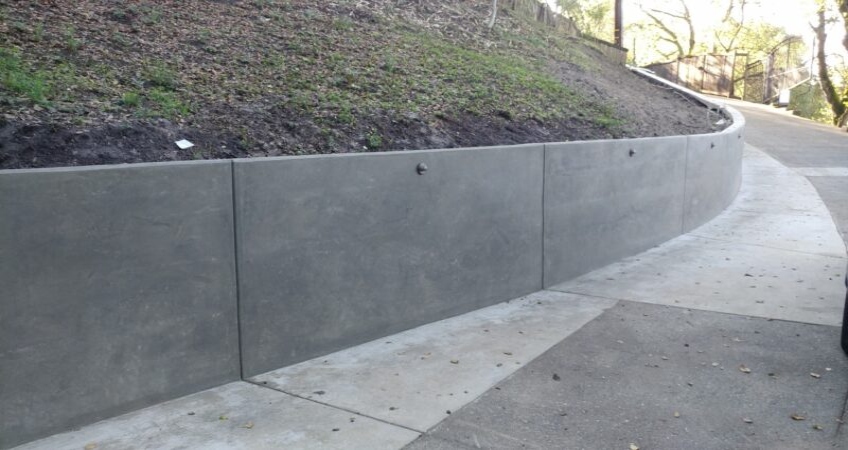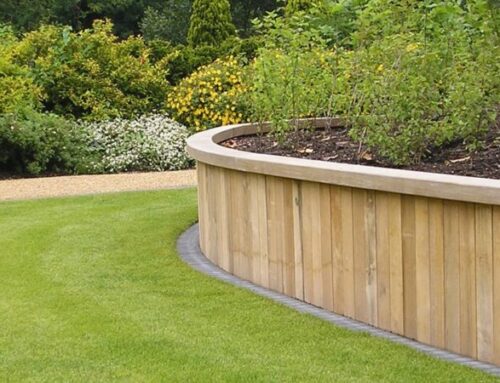Retaining walls serve as constructions designed to keep soil or other substances in place and prevent their movement or erosion. Retaining walls find widespread usage in construction endeavors for creating flat surfaces to support buildings, roads, and other edifices, as well as to thwart soil erosion on inclined landscapes.
A retaining wall is designed to furnish stability and reinforcement to soil or other substances that could potentially move or erode under the influence of gravity, water pressure, or other natural phenomena. A retaining wall can help prevent landslides, soil erosion, and different types of damage that can occur when soil is not adequately supported.
Retaining walls are typically constructed using concrete, stone, brick, or timber materials. The design of a retaining wall will depend on various factors, including the type of soil or other material being retained, the slope of the terrain, and the amount of pressure exerted on the wall.
Multiple kinds of retaining walls exist, such as gravity, cantilever, anchored, and sheet pile walls. Gravity walls depend on their mass to resist the pressure of soil or other substances, whereas cantilever walls employ a horizontal slab or footing to distribute the load of the wall. Anchored walls are reinforced with cables or other supports, and sheet pile walls are made from interlocking steel or concrete sheets.
Importance Of Geotechnical Engineering In The Design And Construction Of Retaining Walls
Geotechnical engineering exerts a substantial influence on both the design and construction of retaining walls. The function of retaining walls is to prevent the collapse or sliding of soil by providing structural support. Retaining walls are frequently employed in diverse civil engineering undertakings, encompassing infrastructure, buildings, bridges, roads, and more.
Here are some of the reasons why geotechnical engineering is vital in the design and construction of retaining walls:
- Soil Analysis: Geotechnical engineers conduct a thorough analysis of the soil to determine its properties, such as density, strength, and stability. This information is crucial in designing a retaining wall that can withstand the pressure and weight of the soil it will hold back.
- Wall Design: Geotechnical engineers use soil analysis data to design a retaining wall that is strong enough to withstand the forces acting on it. This involves selecting the appropriate wall type, such as gravity walls, cantilever walls, or anchored walls, based on the soil conditions and the desired height of the wall.
- Material Selection: The selection of materials is an essential aspect of retaining wall design. Geotechnical engineers consider factors such as durability, strength, and cost when selecting materials for the wall, such as concrete, steel, or reinforced soil.
- Construction Monitoring: During construction, geotechnical engineers monitor the retaining wall’s structure to ensure it is built according to the design specifications. They also perform soil testing to ensure that the soil conditions remain stable and do not pose a risk to the wall’s stability.

Types of Retaining Walls
- Timber – Timber retaining walls are durable and environmentally friendly for maintaining soil and other materials. They can be constructed in various designs, including vertical and sloping configurations, and combined with other materials. Timber walls are flexible, adapting to uneven terrain and soil conditions. Proper construction and regular maintenance are essential for safety, and they may not be suitable for retaining large amounts of soil or in areas with high water pressure. Timber retaining walls offer an affordable and attractive solution for small-scale soil retention projects.
- Precast Concrete – Precast concrete retaining walls are made of precast concrete blocks or panels manufactured off-site and installed on-site. These walls are known for their strength, durability, and resistance to weathering and erosion. Retaining walls can be customised according to specific project requirements and are available in multiple sizes, shapes, and finishes. Installation involves interlocking the blocks or panels and securing them with geogrids, soil anchors, or other reinforcement materials. Precast concrete retaining walls offer easy installation, minimal maintenance, and high load-bearing capacity, making them suitable for retaining large volumes of soil and materials. Proper engineering and regular inspection are crucial for ensuring stability and safety.
- Concrete – Concrete retaining walls are a popular option for stabilising and retaining soil and other materials in construction. These walls are made of durable concrete that can withstand high loads and pressures. They can be designed in various shapes and sizes with customisable finishes. Construction typically involves pouring concrete into precast or cast-in-place forms and reinforcing it with steel bars or mesh. Proper design and engineering are crucial, and regular maintenance is necessary to ensure safety. Concrete retaining walls are versatile and suitable for various applications, including highways, bridges, and residential landscaping. They resist weathering, erosion, and other environmental factors, making them ideal for retaining soil and materials in harsh weather conditions.
- Gravity Walls – Gravity retaining walls stabilise soil and other materials using their own weight and gravity to counteract the pressure. Usually, retaining walls are constructed with materials like concrete, stone, or other dense materials and are designed with a slight slope to ensure proper drainage. The design depends on wall height, retained material weight and type, soil type, and slope angle. Proper engineering and construction to industry standards are essential for stability and durability. Regular maintenance and inspections are crucial to maintaining the structural integrity of retaining walls. Gravity retaining walls can prevent soil erosion, improve drainage, and provide long-lasting stability for various construction projects with proper design and construction.
- Cantilever walls – Cantilever retaining walls are commonly used in construction to maintain soil and materials. Unlike gravity walls, they rely on their design to resist the pressure of the enclosed material. Cantilever walls consist of a vertical stem and a wider base slab that creates a lever arm to support the weight of the retained materials. Typically made of reinforced concrete, retaining walls can be designed in diverse shapes and configurations, such as L-shaped or T-shaped structures. Proper engineering and construction are crucial to ensure their stability and durability. Regular maintenance and inspection are also essential to identify any signs of damage or failure. With their efficient use of materials and ability to resist high pressures, cantilever walls are a popular choice for many construction projects.
Factors to Consider in Retaining Wall Design
- Soil Properties and Characteristics – Soil properties play a crucial role in the design of retaining walls. Soil type, moisture content, density, compaction, shear strength, and angle of repose must be considered to ensure wall stability. Ground slope, wall height, and load-bearing capacity are also important factors to consider.
- Water Pressures and Drainage – Water pressures and drainage are critical considerations when designing and constructing retaining walls. Improper drainage can lead to soil erosion and weaken the wall, causing it to fail. Drainage systems must be installed to control the water flow and prevent it from accumulating behind the wall. The wall design must also consider potential water pressure and incorporate mechanisms such as weep holes or drainage channels to release water pressure.
- Slope Stability Analysis – Slope stability analysis involves assessing the potential for soil movement and collapse, which can compromise the stability of a retaining wall. Factors affecting slope stability include soil type, slope angle, wall height, and load. Engineers use this analysis to determine appropriate design and construction methods, which may consist of reinforcement and proper drainage to maintain slope stability and ensure the reliability of the wall.
- Design Loads and Surcharges – Design loads on a wall are forces from retained soil and materials. Soil weight varies based on type, slope, and height. Surcharges from parked vehicles, buildings, or structures must also be considered.
- Seismic Considerations – Seismic activity can impact a retaining wall’s structural integrity. To mitigate these risks, designers consider the site’s seismic hazard level, soil type, wall’s height, slope, and use of specialised materials to withstand lateral forces and stresses during an earthquake.
Process of Retaining Wall Construction
- Excavation And Preparation Of Foundation – The foundation is a crucial element in constructing a retaining wall, as it supports the wall’s stability and longevity. The first step is to clear and level the site, followed by excavation to create a stable base for the wall. The depth and width of the excavation will depend on various factors, such as the height and width of the wall and the geologic conditions of the site. The foundation should be excavated below the frost line to prevent frost heave from damaging the wall. Once the excavation is complete, the foundation must be compacted and levelled to support the wall’s weight. Gravel or crushed stone layers may be added and compacted to create a solid base. Proper excavation and foundation preparation are essential for a strong and stable retaining wall.
- Placement And Compaction Of Backfill Material – Proper placement and compaction of backfill material are crucial in building a stable retaining wall. Backfill material provides support and stability to the wall. The first layer should be placed immediately after the wall is built, followed by subsequent 8-inch layers, and compacted with a vibratory plate or roller. Attention to compaction is significant near the top of the wall to withstand pressure. Proper grading is also necessary to direct water away from the wall and prevent erosion.
- Installation Of Drainage And Waterproofing Systems – Retaining wall construction requires proper drainage and waterproofing systems to prevent water damage. Drainage systems consist of gravel or crushed stone to promote drainage and perforated pipes to direct water away from the wall. Waterproofing systems, such as membranes or coatings, protect the wall from water penetration. Proper installation of these systems is crucial for the stability and durability of the wall.
- Placement Of Reinforcement And Concrete – Proper reinforcement and concrete placement are crucial to retaining wall construction. Reinforcement materials such as steel bars or wire mesh provide additional strength to the concrete wall. Builders create a reinforcement grid in the correct location as specified in the design plans, which is then secured in place. Concrete is poured into the forms in layers and compacted using a vibrating tool to eliminate air pockets. Proper embedding of the reinforcement within the concrete ensures maximum strength and stability. After curing for several days, the forms can be removed. Correct support and concrete placement are essential to resist lateral forces and stress on the wall over time, creating a durable and reliable structure.
- Quality Control And Testing – Quality control and testing are essential for retaining wall construction to meet industry standards and perform as expected. Inspections of materials and workmanship should be conducted regularly to identify and address any issues. Testing methods like load, soil, and moisture help assess wall strength and identify potential weaknesses. Detailed records of the construction process should be maintained to ensure compliance with local regulations. By incorporating these processes, builders can ensure the retaining wall’s safety, durability, and longevity.
Maintenance and Repair of Retaining Walls
Retaining walls are primarily constructed to prevent soil erosion and retain the soil at its original location. They are commonly used in landscaping, civil engineering, and construction projects. Over time, these walls may require maintenance and repair to ensure their stability and safety. Here are some tips for maintaining and repairing retaining walls:
- Regular Inspections: Make it a routine to examine your retaining wall for any indications of damage, such as cracks, bulges, or tilting. Verify that the drainage system is in good working order during the inspection.
- Clean and Remove Debris: Clear any debris that may have accumulated behind or around the wall and clean the surface. Accumulated debris can cause water damage or erosion to the wall.
- Repair Cracks and Holes: Fill in any cracks or holes in the wall with a suitable patching compound. Make sure to clean the area thoroughly before applying the patch.
- Fix Drainage Issues: Ensure the drainage system functions correctly, as improper drainage can lead to water damage and erosion.
- Reinforce the Wall: In cases of severe damage, reinforcement may be necessary. This can include adding extra support, such as steel or concrete, or installing a new retaining wall.
- Seek Professional Help: If you require clarification regarding the state of your retaining wall or if the repairs are beyond your proficiency, it is advisable to seek the help of a professional contractor or engineer.
Remember, regular maintenance and repair of retaining walls can extend their lifespan and ensure the safety of your property.
In conclusion, the expertise of geotechnical engineers is crucial in ensuring the safety and effectiveness of retaining walls. These structures play a vital role in providing stability and preventing soil erosion, but without proper design and construction, they can pose a significant risk to public safety. Geotechnical engineers have the knowledge and skills to assess the soil conditions, design a retaining wall to withstand the loads placed on it, and ensure it is constructed correctly. By engaging the services of geotechnical engineers, we can ensure that our retaining walls are safe and effective and provide long-term stability to our structures and infrastructure.



